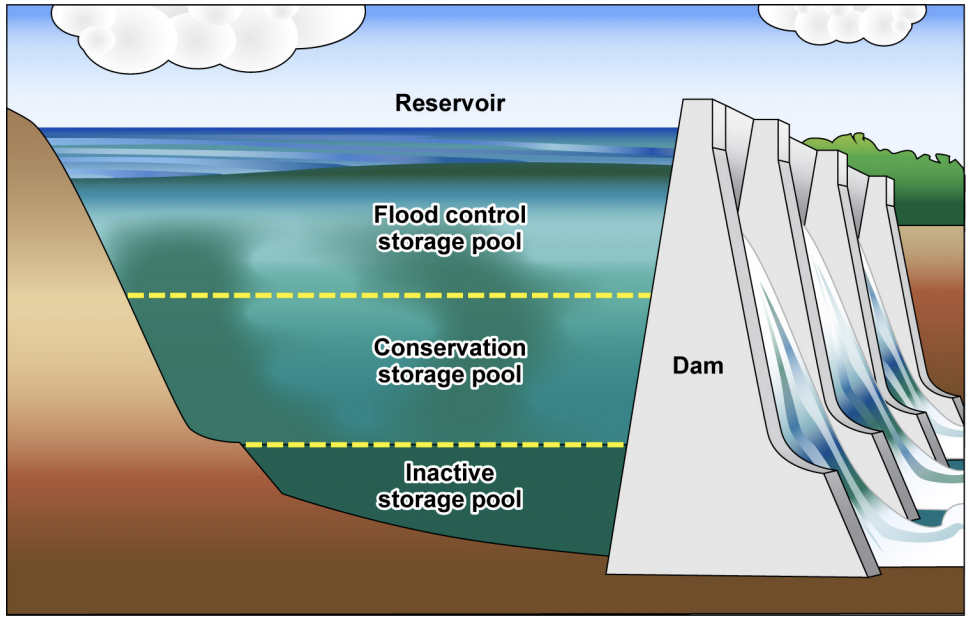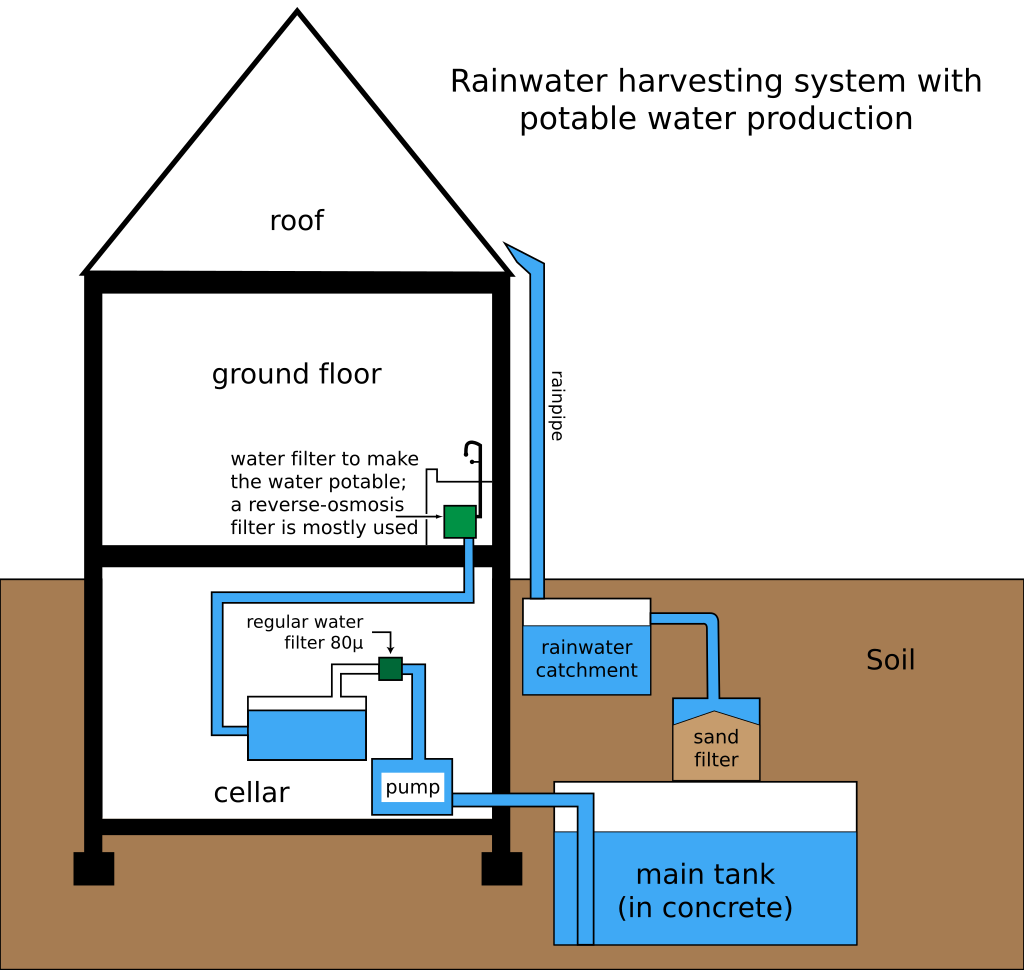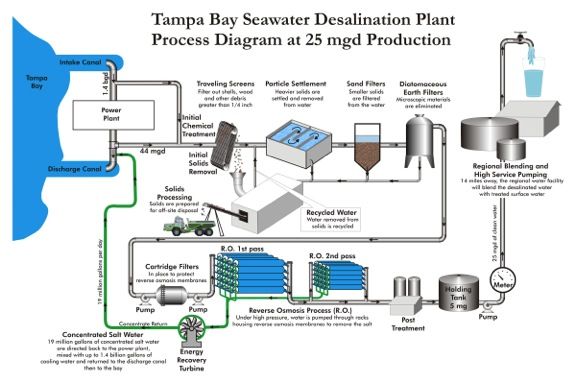IB Syllabus focus:
‘Increase supplies via dams, reservoirs, rainwater capture, wetland enhancement and desalination (e.g., reverse osmosis through semi-permeable membranes).’
Expanding water supply is critical to meeting global demands for households, agriculture, and industry. Methods such as storage and desalination provide essential tools for water security.
Expanding Supply: Storage and Desalination
The Need for Expanded Supply
Water scarcity and stress affect billions worldwide. Growing populations, industrialisation, and climate variability increase demand, while natural supplies remain finite. Storage infrastructure and desalination technologies aim to bridge the gap between demand and supply.
Storage Methods
Dams and Reservoirs
Dams are large barriers constructed across rivers to control water flow and create reservoirs.
Reservoirs are artificial lakes formed behind dams, storing freshwater for drinking, irrigation, and industry.

Illustration of a multi-purpose reservoir with labelled pools (flood pool, conservation storage, and inactive/storage for sediment). The graphic highlights how storage volume is allocated to secure water supplies while retaining flood-control capacity; mention of hydropower use appears as contextual extra detail beyond the syllabus focus. Source.
Benefits:
Reliable year-round water supply.
Hydroelectric power generation.
Flood control and recreational opportunities.
Drawbacks:
Habitat destruction and loss of biodiversity.
Displacement of human populations.
Sedimentation reducing capacity over time.
Rainwater Capture
Rainwater harvesting involves collecting precipitation directly from roofs or surfaces for later use.

Labeled schematic of a household rainwater harvesting system, from roof catchment and gutters to storage cistern and distribution. The diagram includes a filtration box for potable use, which is additional detail not required by the syllabus but clarifies common system components. Source.
Simple and low-cost.
Reduces demand on municipal water systems.
Effective in both rural and urban areas, particularly where infrastructure is limited.
Wetland Enhancement
Wetlands act as natural water storage systems, retaining floodwater, replenishing aquifers, and filtering pollutants. Enhancing or restoring wetlands:
Increases water availability during dry periods.
Improves biodiversity and ecosystem services.
Reduces flood risk in nearby areas.
Desalination
What is Desalination?
Desalination: The process of removing salts and minerals from seawater or brackish water to produce freshwater.
It is especially important in arid regions and coastal areas with limited freshwater resources.
Main Techniques
Reverse Osmosis
Reverse osmosis (RO) is the most common modern desalination method.

Diagram of a seawater reverse osmosis (SWRO) plant showing intake, screening and filtration pretreatment, the high-pressure RO membrane stage, brine discharge, and post-treatment before distribution. This illustrates the semi-permeable membrane concept required by the syllabus; note that the pretreatment steps depicted are extra detail not required for IB ESS SL. Source.
Involves forcing seawater through a semi-permeable membrane under high pressure.
Membrane allows water molecules to pass but blocks salts and impurities.
Semi-permeable membrane: A thin barrier that permits the passage of certain small molecules (like water) while preventing larger molecules or salts.
Thermal Distillation
Uses heat to evaporate seawater, then condenses the vapour as freshwater.
Energy-intensive but effective.
Often used where cheap energy sources are available (e.g., oil-rich countries).
Environmental and Economic Considerations
Environmental Impacts
Brine discharge: Highly concentrated saltwater by-product can harm marine ecosystems.
Energy use: Both RO and distillation require large energy inputs, increasing greenhouse gas emissions if powered by fossil fuels.
Land use: Large facilities may disrupt coastal habitats.
Economic Costs
High infrastructure costs for building plants and pipelines.
Operational expenses linked to energy, maintenance, and skilled labour.
More affordable in wealthier regions but less accessible to low-income countries.
Integrating Storage and Desalination
Complementary Approaches
Storage and desalination often work best together:
Dams and reservoirs ensure consistent supply but depend on rainfall.
Desalination provides a reliable source in drought-prone or arid regions.
Rainwater harvesting and wetlands enhance sustainability at smaller scales.
Balancing Supply and Sustainability
Over-reliance on dams may harm ecosystems.
Excessive desalination increases carbon footprints.
Integrated water resource management combines multiple strategies to balance human needs and environmental health.
Key Points for IB ESS Students
Understand the role of storage systems (dams, reservoirs, rainwater, wetlands) in managing water availability.
Explain desalination processes, focusing on reverse osmosis and semi-permeable membranes.
Evaluate environmental and economic trade-offs.
Recognise the importance of combining methods to achieve sustainable water security.
FAQ
Reservoirs can alter the natural flow of rivers by reducing seasonal flooding and trapping sediment. This reduces nutrient delivery to downstream ecosystems, affecting fish and plant populations.
They may also change water temperature and oxygen levels released downstream, disrupting species adapted to natural conditions. Controlled releases, known as environmental flows, can help mitigate these impacts.
Reverse osmosis generally requires less energy than thermal methods, especially when combined with energy-recovery systems.
It is also more scalable and suited to large coastal cities, where consistent supplies of seawater are available. Thermal distillation tends to be favoured only in regions where energy costs are very low, such as oil-rich states.
Urban settings often face:
Limited roof space relative to population demand
Contamination risks from pollutants on roof surfaces
High variation in rainfall patterns, making storage inconsistent
Despite these, rainwater harvesting remains valuable for reducing pressure on municipal supplies and supporting local water independence.
Wetlands act as natural sponges, slowing down surface runoff and allowing water to infiltrate the soil.
This infiltration replenishes aquifers, which can later be tapped for irrigation and drinking supplies. Enhancing wetlands through restoration projects increases both water storage and the resilience of ecosystems.
Dams often displace communities and submerge agricultural land. The relocation process can lead to loss of livelihoods and cultural heritage.
Social conflicts may arise if benefits, such as reliable water or electricity, are not equitably shared. Careful planning and stakeholder consultation are essential to reduce these issues.
Practice Questions
Question 1 (2 marks)
Define desalination and state one environmental drawback of its use.
Mark Scheme:
1 mark for correct definition: “The process of removing salts and minerals from seawater or brackish water to produce freshwater.”
1 mark for identifying a valid environmental drawback (e.g., brine discharge harming marine life, high energy use increasing greenhouse gas emissions, coastal habitat disruption).
Question 2 (5 marks)
Explain how dams/reservoirs and desalination can be used together to improve water security. In your answer, discuss one advantage and one limitation of each method.
Mark Scheme:
Up to 2 marks for describing how dams/reservoirs provide storage and regulate supply (e.g., storing water for dry seasons, controlling floods).
Up to 2 marks for describing how desalination provides a reliable source independent of rainfall (e.g., useful in drought-prone or arid regions).
1 mark for explaining the complementary nature of using both together (e.g., reservoirs depend on rainfall, desalination compensates during drought; desalination ensures supply but storage helps reduce pressure and balance demand).
Award up to 1 mark within each section for clear advantages (e.g., reliable supply, hydropower generation for dams; consistent output from desalination) and up to 1 mark for clear limitations (e.g., ecosystem damage, displacement for dams; energy costs, brine discharge for desalination).
Maximum 5 marks.

